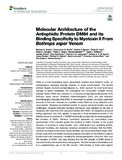Mostrar el registro sencillo del ítem
Molecular architecture of the antiophidic protein DM64 and its binding specificity to myotoxin II from Bothrops asper venom
| dc.creator | Silva Soares, Bárbara da | |
| dc.creator | Rocha, Surza Lucia Gonçalves | |
| dc.creator | Almeida Bastos, Viviane | |
| dc.creator | Borges Lima, Diogo | |
| dc.creator | Costa Carvalho, Paulo | |
| dc.creator | Gozzo, Fabio Cesar | |
| dc.creator | Demeler, Borries | |
| dc.creator | Williams, Tayler L. | |
| dc.creator | Arnold, Janelle | |
| dc.creator | Henrickson, Amy | |
| dc.creator | Jørgensen, Thomas J.D. | |
| dc.creator | Souza, Tatiana de Arruda Campos Brasil de | |
| dc.creator | Perales, Jonas | |
| dc.creator | Valente, Richard H. | |
| dc.creator | Lomonte, Bruno | |
| dc.creator | Gomes Neto, Francisco | |
| dc.creator | Neves Ferreira, Ana Gisele da Costa | |
| dc.date.accessioned | 2022-02-23T14:45:22Z | |
| dc.date.available | 2022-02-23T14:45:22Z | |
| dc.date.issued | 2022 | |
| dc.identifier.citation | https://www.frontiersin.org/articles/10.3389/fmolb.2021.787368/full | |
| dc.identifier.issn | 2296-889X | |
| dc.identifier.uri | https://hdl.handle.net/10669/85839 | |
| dc.description.abstract | DM64 is a toxin-neutralizing serum glycoprotein isolated from Didelphis aurita, an ophiophagous marsupial naturally resistant to snake envenomation. This 64 kDa antitoxin targets myotoxic phospholipases A2, which account for most local tissue damage of viperid snakebites. We investigated the noncovalent complex formed between native DM64 and myotoxin II, a myotoxic phospholipase-like protein from Bothrops asper venom. Analytical ultracentrifugation (AUC) and size exclusion chromatography indicated that DM64 is monomeric in solution and binds equimolar amounts of the toxin. Attempts to crystallize native DM64 for X-ray diffraction were unsuccessful. Obtaining recombinant protein to pursue structural studies was also challenging. Classical molecular modeling techniques were impaired by the lack of templates with more than 25% sequence identity with DM64. An integrative structural biology approach was then applied to generate a three-dimensional model of the inhibitor bound to myotoxin II. I-TASSER individually modeled the five immunoglobulin-like domains of DM64. Distance constraints generated by cross-linking mass spectrometry of the complex guided the docking of DM64 domains to the crystal structure of myotoxin II, using Rosetta. AUC, small-angle X-ray scattering (SAXS), molecular modeling, and molecular dynamics simulations indicated that the DM64-myotoxin II complex is structured, shows flexibility, and has an anisotropic shape. Inter-protein cross-links and limited hydrolysis analyses shed light on the inhibitor’s regions involved with toxin interaction, revealing the critical participation of the first, third, and fifth domains of DM64. Our data showed that the fifth domain of DM64 binds to myotoxin II amino-terminal and beta-wing regions. The third domain of the inhibitor acts in a complementary way to the fifth domain. Their binding to these toxin regions presumably precludes dimerization, thus interfering with toxicity, which is related to the quaternary structure of the toxin. The first domain of DM64 interacts with the functional site of the toxin putatively associated with membrane anchorage. We propose that both mechanisms concur to inhibit myotoxin II toxicity by DM64 binding. The present topological characterization of this toxin-antitoxin complex constitutes an essential step toward the rational design of novel peptide-based antivenom therapies targeting snake venom myotoxins. | es_ES |
| dc.description.sponsorship | Fundação Oswaldo Cruz/[INOVA GC VPPCB-007-FIO-18-2-9]/Fiocruz/Brasil | es_ES |
| dc.description.sponsorship | Fundação de Amparo à Pesquisa do Estado do Rio de Janeiro/[APQ1 E-6/010.001929/2019]/FAPERJ/Brasil | es_ES |
| dc.description.sponsorship | Conselho Nacional de Desenvolvimento Científico e Tecnológico/[Universal 426290/2018-6]/CNPq/Brasil | es_ES |
| dc.description.sponsorship | National Institutes of Health/[GM120600]/NIH/Estados Unidos | es_ES |
| dc.description.sponsorship | National Science Foundation/[NSF-ACI-1339649]/NSF/Estados Unidos | es_ES |
| dc.description.sponsorship | San Diego Supercomputer Center/[TG-MCB070039N]/SDSC/Estados Unidos | es_ES |
| dc.description.sponsorship | Texas Advanced Computing Center/[TG457201]/TACC/Estados Unidos | es_ES |
| dc.language.iso | eng | es_ES |
| dc.source | Frontiers in Molecular Biosciences,, vol.8, pp.1-24. | es_ES |
| dc.subject | Cross-linking (XL) | es_ES |
| dc.subject | Mass spectrometry | es_ES |
| dc.subject | Immunoglobulin fold | es_ES |
| dc.subject | Structural biology | es_ES |
| dc.subject | Toxin neutralisation | es_ES |
| dc.subject | Protein inhibitor | es_ES |
| dc.subject | Snake envenomation | es_ES |
| dc.subject | Antiophidic activity | es_ES |
| dc.subject | Veneno de serpiente | es_ES |
| dc.title | Molecular architecture of the antiophidic protein DM64 and its binding specificity to myotoxin II from Bothrops asper venom | es_ES |
| dc.type | artículo original | |
| dc.identifier.doi | 10.3389/fmolb.2021.787368 | |
| dc.description.procedence | UCR::Vicerrectoría de Investigación::Unidades de Investigación::Ciencias de la Salud::Instituto Clodomiro Picado (ICP) | es_ES |
Ficheros en el ítem
Este ítem aparece en la(s) siguiente(s) colección(ones)
-
Microbiología [1171]


